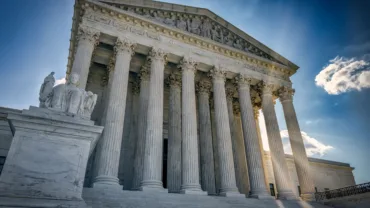A step-by-step guide, overview, cause of action news and other resources.
Legal terms • cause of action
Cause of action (COA), is a commonly used acronym and the epicenter of a lawsuit. The significance of the term lies in the fact that a trial can begin only after its existence is established. Clarifying a general legal issue with a specific CoA is one of the trickiest questions to answer among the host of other questions related to any given case.
This how-to guide serves as a general reference for both novices and any seasoned lawyers looking for a thorough review of the topic before proceeding to more in-depth analysis and research.
If you’re facing a legal issue, use an online database of attorneys in your city or search for an attorney by legal issue after reading this guide.
 | CoCounselRelevant answers to your complex legal questions. |
Jump to:
| What is a cause of action? |
| Cause of action examples |
| Cause of action news |
| How to identify the cause of action |
| 1. Establish a legal possessory right |
| 2. Determine defendant’s duty to act |
| 3. Prove wrong toward the plaintiff |
| 4. Establish the concurrence of right, duty, and wrong |
| 5. Prove damage or loss |
| 6. Demonstrate concurrence of wrong and damage |
What is cause of action?
Cause of action is the legal claim [a claim that sometimes goes unstated] that allows a party to seek judicial relief. This gives the legal right to seek a remedy because of the act or omission, failure to perform duty, or breach of obligation of the defendant towards the plaintiff.
Black’s Law Dictionary defines COA as “a group of operative facts giving rise to one or more bases for suing; a factual situation that entitles one person to obtain a remedy in court from another person.”
Now, providing a uniform and precise definition of the cause of action is impossible. According to Edwin. E. Bryant, cause of action may be defined as a situation or state of facts entitling a party to maintain an action before a judicial tribunal. Such facts may include:
- Defendant violating the Plaintiff’s right, or
- The action or omission of the Respondent threatens the plaintiff’s rights against which the plaintiff can adopt preventive and restraining measures or
- Doubts concerning some duty or right, or confusion about the right beclouded due to apparent adverse right or claim of the plaintiff, which the plaintiff is entitled to have cleared up, that he may safely perform his duty or enjoy his property.
The essential elements for constituting a specific cause of action are covered by the following:
- Statutes — This is one of the most important sources for determining whether a case constitutes a valid cause of action. A statute is a legislative enactment that describes the rights and duties of the stakeholders covered under it. If an act or omission does not constitute a valid right or does not impose any liability, the same cannot be considered a valid cause of action.
- Administrative regulation — Certain administrative regulations impose legal liability on the executive machinery to safeguard and enforce the rights of the people. In case of non-performance of those liabilities, it results in a valid cause of action.
- Judicial precedent — Sometimes, the statutory languages or the administrative actions cannot properly determine whether something can be considered a valid cause of action. In such times, the judicial precedents serve as a guide to determine whether something constitutes a valid cause of action.
- The Constitution — A constitution is the supreme legal document of a sovereign state from which all the statutes, legal machinery, executives, etc., gain their legality and authority. The supreme authority of the Constitution is the last source to determine whether a certain action or omission can constitute a valid cause of action.
However, the elements depend on the type of litigation (e.g., key elements that arise in commercial litigation). In federal litigation, cause of action is only recognized if a right enshrined in the Constitution is violated and affirmative action can be initiated before the federal court.
What are common examples of cause of action?
Breach of contract is one of the most common contractual CoAs with over 10,000 relevant cases available for analysis
Source: Westlaw Precision search tool with cause of action filter
Jump to:
1. Breach of contract cause of action:
A contract is a legally binding agreement between or among two or more parties, imposing certain responsibilities upon the signatories. In simpler words, each party becomes liable to the other for honoring and performing or not performing certain legal activities stipulated in the contract. Such performance may include simple obligations like delivery of goods or providing services to complicated commercial transactions like mergers and acquisitions.
Irrespective of the contractual nature, non-performance of one or more contractual obligations by one party results in severe financial, reputational, legal or other forms of damages to the other party (or parties). This is where the cause of action from breach of contract arises where one party suffers damage because of dishonor and non-performance of contractual terms by the other. This allows the sufferer to initiate a civil lawsuit and, at times, a criminal lawsuit against the breacher.
Therefore, from the given example, we can disseminate four essential elements of a cause of action required to bring a lawsuit:
- Existence of a contract between the parties.
- Performance (or non-performance with legally tenable justification) by one party, i.e. plaintiff.
- Non-performance by the other party or parties (Respondent) without legally tenable justification.
- Damage caused to the plaintiff due to such non-performance.
Imagine being admitted to a federal court pro hac vice to represent a long-standing firm client in a contract dispute; your client insists you represent them. You face an important decision: to take on the case or refer it out. Download a free litigation playbook and gain insights on how to defend against a breach of contract dispute.
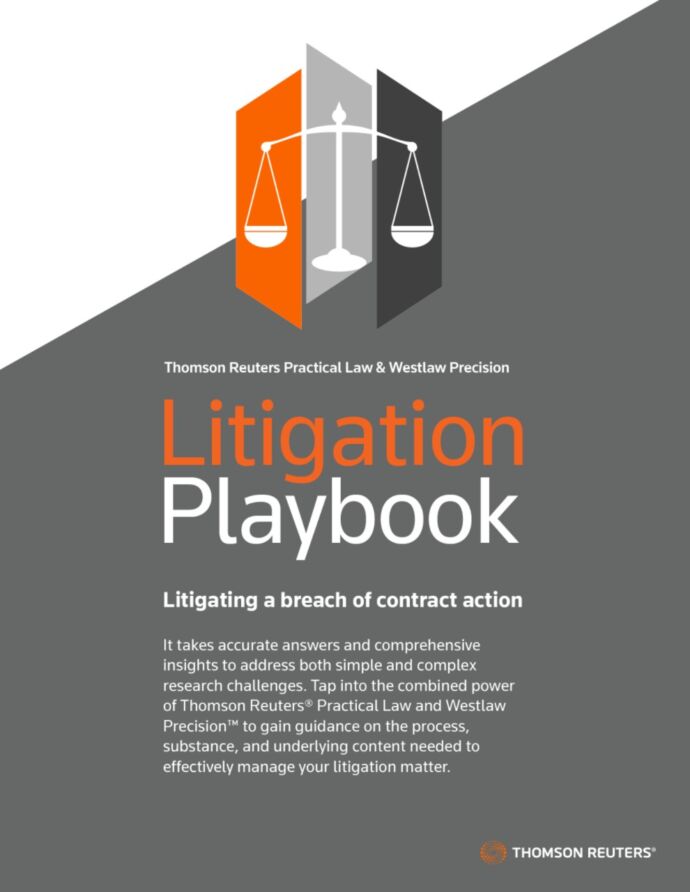 | Playbook by Practical Law Litigating a breach of contract action: The answers you need and how to proceed when litigating a matter. |
2. Statutory cause of action:
Certain actions are dependent on regulations or statutory laws such as warranty claims. These causes of action emerge in regard to sales of goods. For instance, there is cause of action for breach of express warranty (which is incorporated under § 2-313 of the Uniform Commercial Code) if the seller makes a false representation of material fact and the plaintiff suffers a loss due to the reliance on it.
3. Tort-related cause of action:
Fraudulent misrepresentation
- The defendant makes a false representation regarding material fact;
- The plaintiff relies on the fraudulent misrepresentation;
- Results in the loss or injury to the plaintiff.
The benefit-of-the-bargain makes the recovery of suffered harm possible in order to reinstate the position of the plaintiff considering the situation of correct representations.
Conversion
This is equivalent to intentionally depriving the interest of the plaintiff in property through the unauthorized act and causing loss. The default remedy is the damages, considering the fair market value of the property or returning the property.
Negligence
The four essential constituents of negligence are:
- The existence of the legal duty of the defendant;
- Failure or omission to perform the duty
- Harm sustained by the plaintiff, and;
- Failure to perform the duty or the negligent act of the defendant, which subsequently results in the cause of action in the suit.
Defamation
A derogatory and false statement, verbal or written, made with malice or negligence by the defendant to the third party leading to the loss or injury to the plaintiff’s reputation. (It is subject to the statement that was not made under underprivileged circumstances).
 | Litigating in New York? Review a list of major torts that lead to cause of action |
4. Precedent cause of action
These actions arise depending upon the common law or precedents in which claims are based on certain facts identified by courts.
5. Equity-related cause of action
Unjust enrichment is an equity-related cause of action that applies when there is no express contract between the parties. This doctrine is based on mistaken payment and the plaintiff can recover the amount equal to the advantages and services which he provided to the defendant.
Cause of action news
Updated samples of the latest news related to cause of action developments.
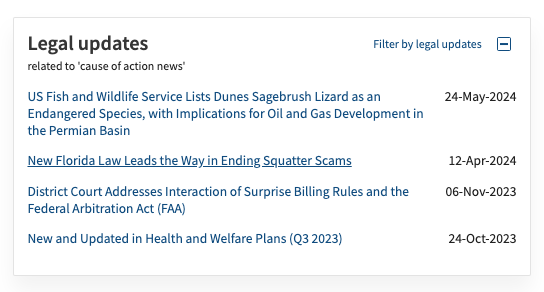 | Stay up to date The latest legal updates for corporate law departments |
New Florida Law Leads the Way in Ending Squatter Scams
On July 1, 2024, Florida Session Law 2024-44 (the Act) takes effect, providing homeowners a swift new process for removing unauthorized persons (squatters) from their property without judicial action. The new law, passed unanimously by the Florida Legislature, is in response to high-profile squatter cases nationwide and creates criminal penalties for persons unlawfully occupying residential property and refusing to leave when asked.
Cause of Action for Wrongful Removal
Critics of the Act warn that the new non-judicial remedy raises due process concerns and that unscrupulous landlords may use it as a shortcut to the regular eviction process. However, the Act creates a civil cause of action for a wrongly removed person to regain possession and recover from the landlord actual damages and statutory damages equaling three times the fair market rent of the dwelling, in addition to court costs and reasonable attorneys’ fees.
Source: New Florida Law Leads the Way in Ending Squatter Scams, Practical Law Legal Update w-042-9583
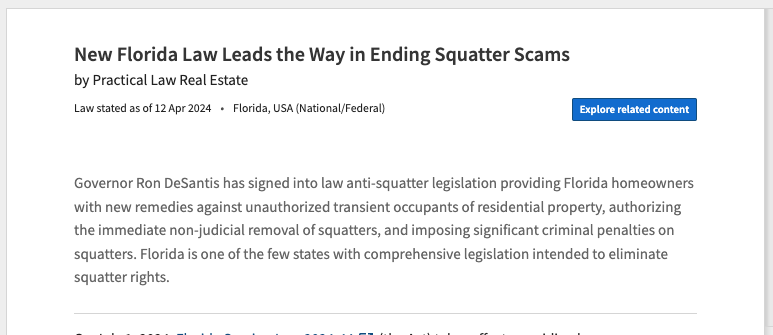 | Already a subscriber? Practical Law Connect: New Florida Law Leads the Way in Ending Squatter Scams |
How do you identify the cause of action?
Identifying the cause of action requires consideration of two factors – the legal theory and remedy. In the United States, CoA is defined from the standpoint of the rights of plaintiffs and duties of defendants with the breach of duty that resulted in loss and damage.
To institute a lawsuit, a plaintiff must prove all the elements of CoA including wrongful action such as threats. However, wrongful action alone does not trigger a CoA – It is the existence of the injury, damage, or loss that happened due to that wrongful action.
The following 6-step process gives attorneys confidence to specify CoA for their particular case.
Jump to:
1. Establish the existence of a legal possessory right
2. Determine defendant’s legal duty to act
3. Prove wrong or violation toward the plaintiff
4. Establish the concurrence of right, duty, and wrong
6. Demonstrate concurrence of wrong and damage
1 – Existence of a legal possessory right in the plaintiff over the matter
The possessory rights, in this case, mean that the plaintiff’s legal right exists and where the defendant’s act affects that right.
For instance:
- A gives B $100 for 2 months as debt.
- A has the right to bring suit against B if he does not pay after the lapse of time.
- Plaintiff A has the possessory right to being the actual owner of the money creating his legal right and legal obligation on defendant B for payment within the proper time limit.
Case example: Colavito v New York Organ Donor Network, Inc.
The court ascertained the cause of action essentially with regard to the conversion in this matter. The court reasoned that for the cause of action to arise, the plaintiff’s possessory right or interest must exist and the defendant must have dominion over the property or interference with it, in derogation of the plaintiff’s rights.
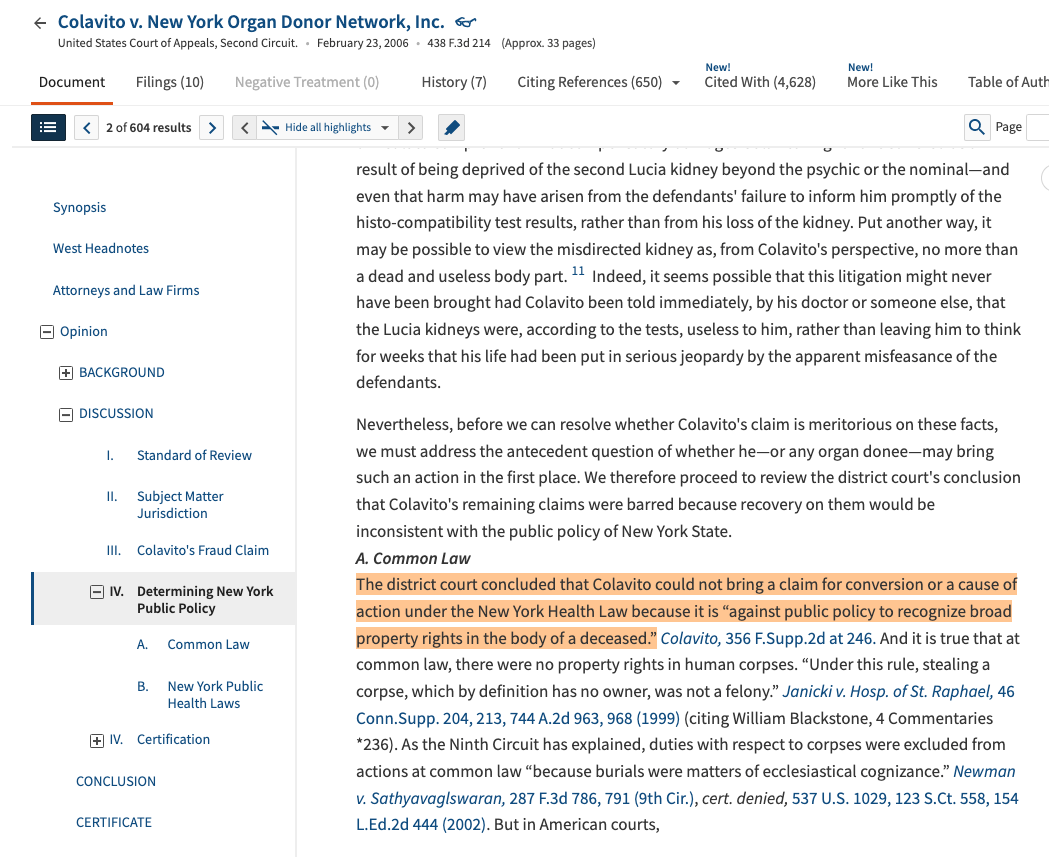
2 – Corresponding legal duty in the defendant toward the plaintiff
The second element of the cause of action corresponds to the primary right of the plaintiff. This duty may arise from a contract or may be imposed by positive law independent of the contract, or it may arise ex contractu or ex delictu (consequences from breaching the contract).
There are several ways to determine whether the defendant had a duty to act:
- The defendant is engaged in the creation of the risk which resulted in the plaintiff’s harm.
- Voluntary undertaking: The defendant volunteered to protect the plaintiff from harm.
- Knowledge: The defendant knows/should know that his conduct will harm the plaintiff.
- Business/voluntary relationships:
- Business owner and customer;
- Innkeeper and guest;
- Land possessor who opens her land to the public;
- A person who voluntarily takes custody of another person.
Case example: Solomon v. Bates (N. C.)
In this case, the theory involves directors that are trustees for creditors, and individually owe a legal duty to them. The directors were wrong acting in a fraudulent, negligent, mismanagement affecting the creditor’s rights.
Case example: Purcell vs R.R 108 N.C 414
The court gave the verdict that the failure to discharge the duty required by the laws was a wrong caused by the defendant’s negligence -tort- and is properly united by the tort by fraud and deceit form part of the complaint.
3 – Wrong or violation of the plaintiff’s right, or breach of duty on the part of the defendant
Duty is the action which is to be done or not done by the person in obligation of it. A cause of action arises wherever there is proof that there was the existence of a duty towards the plaintiff by him which he failed to procure resulting in a breach. For instance, negligence as a Tort is a breach of duty that is not desired by the plaintiff but committed by the defendant.
The Wrongful Act or Omission forms part of the action that leads to affecting the right of the plaintiff.
For instance:
- A buys a horse from B.
- Later he came to know that the horse is suffering from a life-threatening disease.
- As a result, B’s Non-Disclosure of information is part of the Wrongful Act with his clear intention to commit fraud against A.
- Here, A has full rights to bring legal action against B.
Case example: Hart v. Hanson, 14 N.D. 570, 105 N.W. 942 (1905)
The defendants were directors of the State Bank of Northwood, the plaintiff and his assignors became sureties on the such-depositary bond, and the same was delivered to and accepted by the county. County funds were thereupon deposited in the bank and were closed by the state authorities by reason of its insolvency. Here the defendant’s activities are part of the question since they acted fraudulently, as they already knew the insolvency of county funds but they remained silent. They were also the trustees in whose name the creditors invested money. Consequently, the directors were held completely liable to creditors.
When the defendant intentionally interferes with the rights of the plaintiff they lay the foundation for the lawsuit with the cause of action.
Case example: Davenport v. Underwood
The court held the defendant liable. The bank directors were held responsible for causing losses for the bank as they were directly liable to depositors on the grounds of fraud and negligence while performing the corporation’s duties.
Case example: Delano v. Case
In this case, the defendant committed a wrongful act on the ground of negligence. The court ruled that the purpose of cause of action could exist where there has been a liability in the right of the corporation to be enforced.
4 – Concurrence of right, duty, and wrong
According to Salmond “no right can exist without any corresponding duty and vice versa”.
Every person is rendered some rights which are granted to him against individuals or some against the public at large. These rights cannot be taken away. On the other hand, it’s the duty of individuals around him to let him enjoy his right by doing or restraining from doing anything which may hinder it. Rights and duties exist simultaneously.
A right is an interest protected by the law or the state, and it’s the duty that mandates the protection of the right. But when the protection is infringed by a failure to follow the duty, it gives rise to the wrong committed and hence, to a cause of action. This renders another right to claim the damage suffered for the one whose right was infringed.
5 – Damage
When the duty obliged is not performed, the right is infringed causing loss or damage and can be claimed with the cause of action that arose. Damages can be defined as the injury caused or loss incurred by the plaintiff due to the failure of the defendant and can be remedied by issuing the cause of action claiming damages.
Case example: Marzetti v. Williams (1830) 1 B & Ad 41
This case stated that every contract implies a duty to be performed by the parties and in the event of breach, cause of action arises against the party at fault mandating the use of the maxim, Ubi jus ibi remedium. Where there is action given by law, there are damages to the violated right.
6 – Concurrence of wrong and damage
The maxims damnum sine injuria and injuria sine damnum are elaborative of the relationship between the wrong and damage. Damnum sine Injuria refers to damages without injury or damages where there is no infringement of any legal right in spite of the loss which might have been incurred.
On the other hand, Injuria sine damno refers to infringement of legal right without causing any harm, loss, or damage to the plaintiff. Whenever any legal right is infringed, the plaintiff or the one who suffers can bring a cause of action against the one who infringed the right. Therefore, damages are the result of the cause of action through an actionable wrong.
Case example: Clark v. McClurg 215 Cal 279
In order to establish that there was breach of duty, the plaintiff must not only prove the existence of actionable wrong but also damages thereof. It was emphasized that the concurrence of actionable wrong and damages are important for the cause of action to be advanced.
Case example: Mogul Steamship Co Ltd v McGregor, Gow & Co [1892] AC 25
This case established that immoral acts done in a lawful manner led to no legal injury, hence no damages to be claimed by the plaintiff, and no point of the cause of action.
 | Related blog Case law research tools: The most useful free and paid offerings |
Last thoughts for the legal researcher
Although this guide is limited in scope and purpose, it’s clear that your own duty as a lawyer is to be well-versed with the facts of a case and to competently analyze similar cases where possible. This demands significant time and effort in both research and analysis, and understandably so. Yet the energy spent in gathering pertinent definitions and requirements don’t need to be so cumbersome.
The steps laid out above to specify causes of action serve only as basic principles so you can confidently proceed to the next phase of thorough analysis and file a lawsuit.
Originally published on November 17, 2022
Disclaimer
The content appearing on this website is not intended as, and shall not be relied upon as, legal advice. Although this content was created to provide you with accurate and authoritative information, it was not necessarily prepared by attorneys licensed to practice law in a particular jurisdiction. It is general in nature and may not reflect all recent legal developments. Thomson Reuters is not a law firm and an attorney-client relationship is not formed through your use of this website. You should consult with qualified legal counsel before acting on any content found on this website.








